

Fentanyl. Fentanyl (also known as fentanil, brand names Sublimaze,[3] Actiq, Durogesic, Duragesic, Fentora, Matrifen, Haldid, Onsolis,[4] Instanyl,[5] Abstral,[6] Lazanda[7] and others[8]) is a potent, synthetic opioid analgesic with a rapid onset and short duration of action.[9] It is a strong agonist at the μ-opioid receptors.
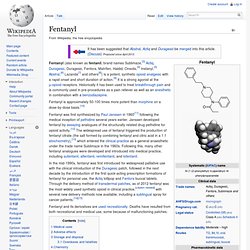
Historically it has been used to treat breakthrough pain and is commonly used in pre-procedures as a pain reliever as well as an anesthetic in combination with a benzodiazepine. Fentanyl is approximately 50-100 times more potent than morphine on a dose-by-dose basis.[10] Fentanyl was first synthesized by Paul Janssen in 1960[11] following the medical inception of pethidine several years earlier.
Fentanyl and its derivatives are used recreationally. Deaths have resulted from both recreational and medical use, some because of malfunctioning patches. Medical uses[edit] Fentanyl transdermal patch (Durogesic/Duragesic/Matrifen) is used in chronic pain management. Heroin. Heroin /ˈhɛroʊɪn/ (diacetylmorphine or morphine diacetate, also known as diamorphine (BAN, INN[4]) and commonly known by its street names of H, smack, boy, horse, brown, black, tar, and others[5] is an opioid analgesic originally synthesized by C.R.
Alder Wright in 1874 by adding two acetyl groups to the molecule morphine, which is found naturally in the opium poppy. Cocaine. Cocaine (INN) (benzoylmethylecgonine, an ecgonine derivative) is a crystalline tropane alkaloid that is obtained from the leaves of the coca plant.[5] The name comes from "coca" and the alkaloid suffix "-ine", forming "cocaine".
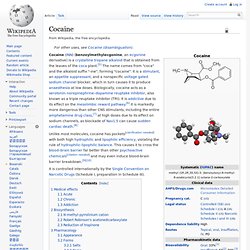
It is a stimulant, an appetite suppressant, and a nonspecific voltage gated sodium channel blocker, which in turn causes it to produce anaesthesia at low doses. Biologically, cocaine acts as a serotonin–norepinephrine–dopamine reuptake inhibitor, also known as a triple reuptake inhibitor (TRI). It is addictive due to its effect on the mesolimbic reward pathway.[6] It is markedly more dangerous than other CNS stimulants, including the entire amphetamine drug class,[7] at high doses due to its effect on sodium channels, as blockade of Nav1.5 can cause sudden cardiac death. Unlike most molecules, cocaine has pockets[clarification needed] with both high hydrophilic and lipophilic efficiency, violating the rule of hydrophilic-lipophilic balance.
Medical effects Acute. Methamphetamine. Methamphetamine[note 1] (pronunciation: /ˌmɛθæmˈfɛtəmiːn/; contracted from N-methyl-alpha-methylphenethylamine) is a neurotoxin and potent psychostimulant of the phenethylamine and amphetamine classes that is used to treat attention deficit hyperactivity disorder (ADHD) and obesity.
Methamphetamine exists as two enantiomers, dextrorotary and levorotary. [note 2] Dextromethamphetamine is a stronger central nervous system (CNS) stimulant than levomethamphetamine; however, both are addictive and produce the same toxicity symptoms at high doses. Although rarely prescribed due to the potential risks, methamphetamine hydrochloride is approved by the United States Food and Drug Administration (USFDA) under the trade name Desoxyn. Recreationally, methamphetamine is used to increase sexual desire, lift the mood, and increase energy, allowing some users to engage in sexual activity continuously for several days straight.
Uses Medical. Monarchism. Monarchism is defined as the advocacy of a monarch or monarchical rule.[1] A monarchist is an individual who supports this form of government, independent from the person, the monarch.
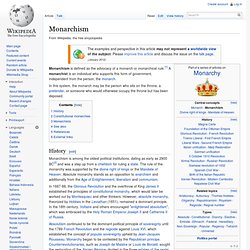
In this system, the monarch may be the person who sits on the throne, a pretender, or someone who would otherwise occupy the throne but has been deposed. History[edit] Absolutism continued to be the dominant political principle of sovereignty until the 1789 French Revolution and the regicide against Louis XVI, which established the concept of popular sovereignty upheld by Jean-Jacques Rousseau.
Monarchy began to be contested by the Republican principe. Amphetamine. Innocence. Bouguereau's L'Innocence: Both young children and lambs are symbols of innocence.
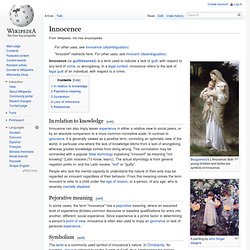
In relation to knowledge[edit] Innocence can also imply lesser experience in either a relative view to social peers, or by an absolute comparison to a more common normative scale. In contrast to ignorance, it is generally viewed as a positive term, connoting an optimistic view of the world, in particular one where the lack of knowledge stems from a lack of wrongdoing, whereas greater knowledge comes from doing wrong. This connotation may be connected with a popular false etymology explaining "innocent" as meaning "not knowing" (Latin noscere (To know, learn)). Winter. Winter (/ˈwɪntər/) is the coldest season of the year in temperate climates, between autumn and spring.
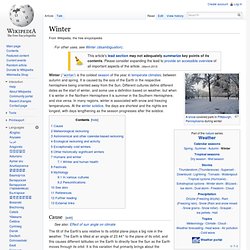
It is caused by the axis of the Earth in the respective hemisphere being oriented away from the Sun. Different cultures define different dates as the start of winter, and some use a definition based on weather, but when it is winter in the Northern Hemisphere it is summer in the Southern Hemisphere, and vice versa. Protagonist. In Shakespeare's Hamlet, Prince of Denmark, Hamlet is the protagonist.
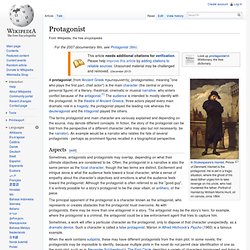
He is set in a tragic situation, where the ghost of his dead father urges him to take revenge on his uncle, who had murdered the father. Portrait of Hamlet by William Morris Hunt, oil on canvas, circa 1864. The terms protagonist and main character are variously explained and depending on the source, may denote different concepts. Bone. The bones of a human foot In the human at birth, there are over 270 bones,[1] but many of these fuse together during development, leaving a total of 206 separate bones in the adult, not counting numerous small sesamoid bones and ossicles.
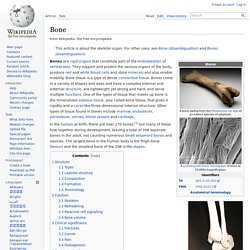
The largest bone in the human body is the thigh-bone (femur) and the smallest bone of the 206 is the stapes. Weakness. "Asthenia" redirects here.

The tortrix moth genus is considered a junior synonym of Epinotia. Diagnostic Distinctions[edit] True weakness vs. perceived weakness[edit] True weakness (or neuromuscular) describes a condition where the force exerted by the muscles is less than would be expected, for example muscular dystrophy.Perceived weakness (or non-neuromuscular) describes a condition where a person feels more effort than normal is required to exert a given amount of force but actual muscle strength is normal, for example chronic fatigue syndrome.[2] In some conditions, such as myasthenia gravis, muscle strength is normal when resting, but true weakness occurs after the muscle has been subjected to exercise.
Asthenia vs. myasthenia[edit] Angel. An angel (from the Greek ἄγγελος - ángelos[1]) is a supernatural being or spirit, often depicted in humanoid form with feathered wings on their backs and halos around their heads, found in various religions and mythologies.
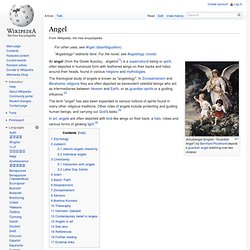
The theological study of angels is known as "angelology". In Zoroastrianism and Abrahamic religions they are often depicted as benevolent celestial beings who act as intermediaries between Heaven and Earth, or as guardian spirits or a guiding influence.[2] The term "angel" has also been expanded to various notions of spirits found in many other religious traditions.
Other roles of angels include protecting and guiding human beings, and carrying out God's tasks.[3] Cotton. Picking cotton in Oklahoma, USA, in the 1890s Cotton is a soft, fluffy staple fiber that grows in a boll, or protective capsule, around the seeds of cotton plants of the genus Gossypium.

The fiber is almost pure cellulose. Good and evil. In many religions, angels are considered good beings. Cream. A milk bottle showing cream risen to the top Cream skimmed from milk may be called "sweet cream" to distinguish it from whey cream skimmed from whey, a by-product of cheese-making. Whey cream has a lower fat content and tastes more salty, tangy and "cheesy".[1]
Milk. Milk is a white liquid produced by the mammary glands of mammals. It is the primary source of nutrition for young mammals before they are able to digest other types of food. Early-lactation milk contains colostrum, which carries the mother's antibodies to the baby and can reduce the risk of many diseases in the baby. It also contains many other nutrients.[1] As an agricultural product, milk is extracted from mammals during or soon after pregnancy and used as food for humans.
Worldwide, dairy farms produced about 730 million tonnes of milk in 2011,[2] from 260 million dairy cows.[3] India is the world's largest producer and consumer of milk, yet neither exports nor imports milk. Throughout the world, there are more than 6 billion consumers of milk and milk products. Frost. Cloud. Stratocumulus stratiformis cumulogenitus.
Surrender (military) Muslims surrender to Spain: Boabdil gives the Granada key to Ferdinand and Isabella Ulysses S. Grant accepting the surrender of Robert E. Lee at Appomattox Court House. Light. A triangular prism dispersing a beam of white light. Sunlight. Atmosphere of Earth. Composition of Earth's atmosphere by volume. The lower pie represents the trace gases which together compose 0.038% of the atmosphere. The numbers are from a variety of years (mainly 1987, with CO2 and methane from 2009) and do not represent any single source. Clean. Peace. White people. Heaven. Ice. Snow. Lack. Illness. God. Emptiness. Softness. Nobility. Virtue. Ghost.